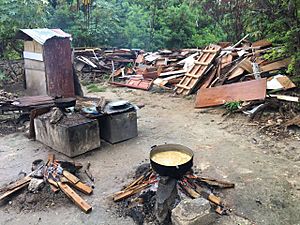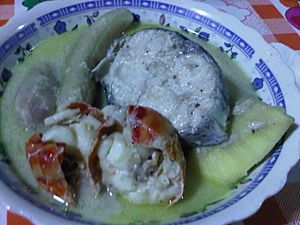Run down facts for kids

A plate of Rondón
|
|
| Alternative names | Rundown, run dun, rondón, fling-me-far, and fling mi for |
|---|---|
| Type | Stew |
| Place of origin | Jamaica, Tobago |
| Main ingredients | Fish (typically mackerel), coconut milk, plantain, yams, tomatoes, onion, seasonings |
Run down is a yummy stew from Jamaica and Tobago. It is also known by other names like rundown, run dun, rondón, fling-me-far, and fling mi for. This special dish is eaten in many countries near the Caribbean Sea.
The stew is made with a thick sauce from coconut milk. It usually has different kinds of seafood like fish, crabs, or small lobsters. Other ingredients include plantains, yams, tomatoes, onions, and tasty seasonings. Often, mackerel fish is used. You can also find it made with other fish like cod, red snapper, or swordfish.
Run down is a popular breakfast dish in Jamaica. It is also common in places like the Antilles, Colombia, Honduras, Panama, Costa Rica, Nicaragua, and Venezuela. People often eat it with dumplings or baked breadfruit.
How Run Down Started
The dish called Rondón began in Jamaica. It became popular in Latin America because Afro-Jamaican workers moved there in the early 1800s. These workers helped build big projects like the Panama Canal and railroads in Costa Rica.
This stew is special to Jamaica. The people living there, who came from Africa, Europe, and Asia, learned to cook with what they had. They used foods that were easy to find, like fish and coconut milk. Even though many Jamaicans have African roots, this dish is not eaten in Africa. Today, you can find it in Tobago and parts of South and Central America where Jamaicans live.
The name Rondón comes from a Jamaican language called Jamaican Patois. It means "run down." This describes how the sauce is "runny" or like a liquid. It could also mean that the fish is cooked so much that it "runs down" or falls apart.
How to Make Run Down

Since rondón is a traditional dish in many countries, the ingredients can change from place to place. But one thing is always the same: coconut milk is a must-have ingredient in all versions!
- In Nicaragua, people might use fish, beef, pork, or even turtle meat. They add bell peppers, onion, bananas, cassava, and other vegetables.
- On the Caribbean coast of Costa Rica, the stew often has cassava, taro, yam, plantain, and green bananas. They use fish, lobsters, or crabs. Spices like thyme, garlic, onions, and a special yellow chili pepper are also added. Sometimes, it's served with flour dumplings.
- On the island of San Andrés in Colombia, the dish uses fish, snails, other seafood, or pork. Vegetables include cassava, taro, plantain, and potatoes. Spices like basil, oregano, peppers, onion, and garlic are common.
- In Panama, seafood cooked with coconut milk can be served with rice, tostones (fried plantains), and salad.
In some coastal areas of Colombia, "rundown" can mean a conch stew. This version might have conch meat, salted pork, root vegetables, breadfruit, and plantains. All of these are cooked in coconut milk.
In Trinidad, Grenada, and Barbados, there is a similar dish called "oil-down." It uses palm oil and is usually made with salted beef or pork, breadfruit, palm oil, and seasonings. These are boiled in coconut milk until the dish becomes thick.
See also
 In Spanish: Rondón (plato) para niños
In Spanish: Rondón (plato) para niños


